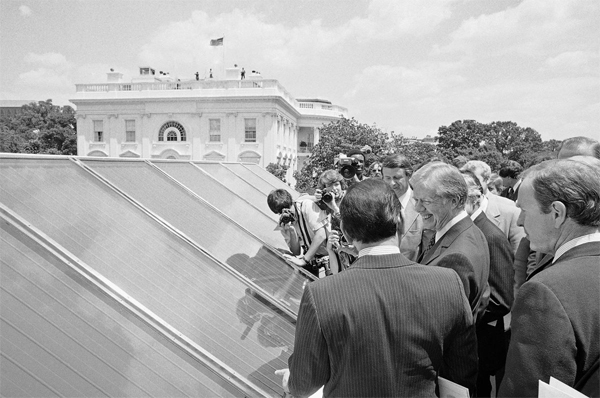The 98-year-old former president was an early champion of solar power who also saw coal as key to the US reducing its dependence on foreign oil

Nathaniel Bullard and Amanda Kolson Hurley, Bloomberg News
NEW YORK/WASSHINGTON
EnergiesNet.com 02 23 2023
Last week Jimmy Carter, the 39th president of the United States, began home hospice care at the age of 98. The news prompted tributes to a man known for his dedication to promoting peace and fighting disease, who has led a famously modest post-presidential life in his hometown of Plains, Georgia.
Carter is also the president who put solar panels on the White House and suggested that Americans wear a sweater and keep the thermostat down to save energy. But that only skims his legacy on energy and the environment, one of the most substantial of any US president.
Carter used an executive order to designate more than 50 million acres of Alaska’s wilderness as federally protected. The Alaska Lands Act he later signed was even bigger, doubling the size of the national parks system. In 1980, Carter signed the law that created the Environmental Protection Agency’s Superfund program for cleaning up toxic waste after the chemical contamination of Love Canal, a Niagara Falls, New York, neighborhood, came to national attention. The EPA recently invoked the same law when it ordered Norfolk Southern Corp. to clean up the damage from the train derailment near East Palestine, Ohio.
Carter’s approach to energy policy was partly defined by the oil crises that roiled the US economy in the 1970s. He entered office in the aftermath of one oil price shock, caused by the 1973 Arab oil embargo, while another shock precipitated by the 1979 Iranian Revolution helped doom his reelection bid. He crafted what his biographer Jonathan Alter called “the nation’s first comprehensive energy policy.” And he had foresight in calling for renewable energy to make up 20% of the nation’s energy mix by 2000 — a target the US still hasn’t met but is finally getting close to.
“[W]e must start now to develop the new, unconventional sources of energy we will rely on in the next century,” he urged the nation in a 1977 address.
Shortly before he left office, Carter’s White House issued a report on global warming which advised that countries limit temperature rises to 2C above preindustrial levels — a goal adopted 35 years later in the Paris Agreement on climate change.
The nation’s fossil fuel consumption had been rising unceasingly for decades when Carter came in. But by 1979 consumption was falling, and it stayed below its 1979 level up until 1991. Key to that were the vehicle efficiency standards enacted in the mid-70s, which ramped up under Carter.
Importantly, the consumption drop happened while the economy was growing (albeit anemically compared to the 1990s and early 2000s). By the end of the 1970s, fossil fuel use and economic growth had decoupled for good in the US.
One controversial form of low-carbon energy Carter supported was nuclear power. When the Three-Mile Island partial meltdown occurred in 1979, he went to Pennsylvania and strolled the plant to assess the situation and ease public fear. He had been a nuclear engineer in the US Navy as a young man — and in an act of heroism, once shut down a malfunctioning reactor in Canada.
A contradiction that stands out about Carter is that the early solar power supporter also championed coal as a solution to US dependence on foreign oil. In a 1978 speech in West Virginia, he even called coal “the most formidable weapon in our defense arsenal.” Although his coal-heavy and intensely deregulatory approach is hard to square with today’s strategies for bettering the environment, it didn’t seem so contradictory back then.
When visiting the Cane Run coal power plant in Kentucky in 1979, Carter remarked upon its sulfur-dioxide scrubbers — among the first of their kind — which reduced the emissions responsible for acid rain. Greater efficiency and more coal were the ways out of America’s energy crisis, he said, adding: “We will also protect our environment. I will not permit America to be forced to choose between breathing foul air and having our waters filthy on the one hand or mortgaging our future to the OPEC oil cartel. We don’t need to do either one.”
Coal power grew significantly during Carter’s time in office, while oil-fired power declined and other energy sources hardly budged. Undergirding that was a set of major regulations and outlays. The Powerplant and Industrial Fuel Use Act of 1978 prohibited the use of gas or oil in any new generator and the Public Utility Regulatory Policies Act, passed the same year, promoted domestic energy resources and renewable power.
Carter also oversaw the creation of the US Department of Energy (although its roots lay in the Manhattan Project, the World War II atomic weapon program). Federal spending on energy research and development peaked in 1979 at $10.6 billion, in constant 2022 dollar terms. Much of the funding flowed to grand experiments — in particular to the Synthetic Fuels Corporation, meant to convert coal into oil. It folded with little to show for its efforts in 1986.
That same year, President Ronald Reagan removed Carter’s solar panels from the White House. They went into government storage. But some of them were put back to use for another two decades, at Maine’s Unity College, a school with an environmental mission.
The panels’ longevity is fitting of their sponsor: Carter has enjoyed the longest post-presidency of any US leader, which he has devoted to humanitarian causes.
Nat Bullard is a senior contributor to BloombergNEF and Bloomberg Green. He is a venture partner at Voyager, an early-stage climate technology investor.
bloomberg.com 02 23 2023











